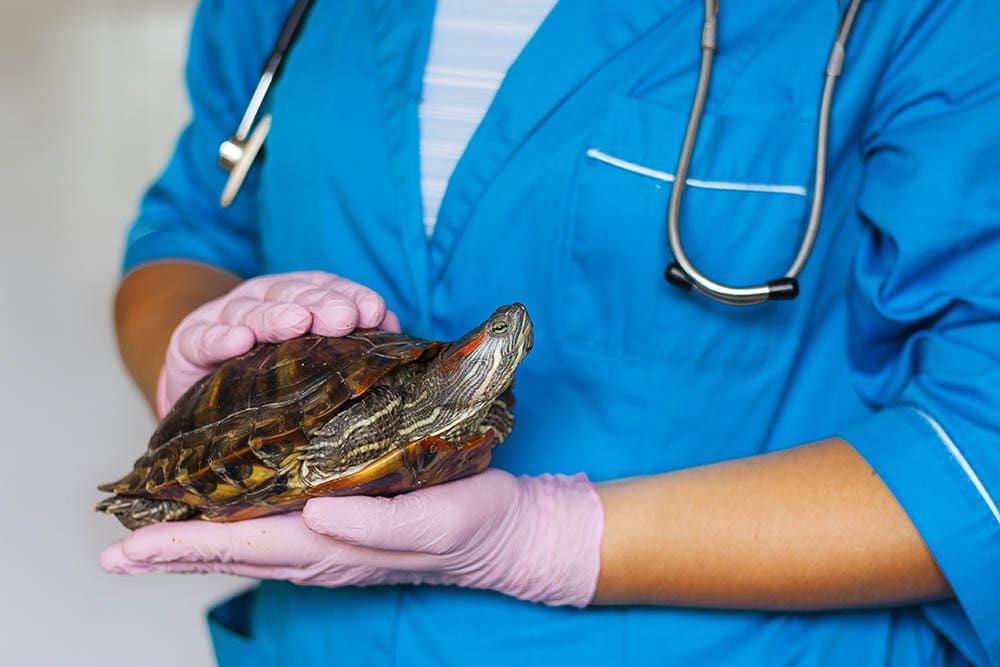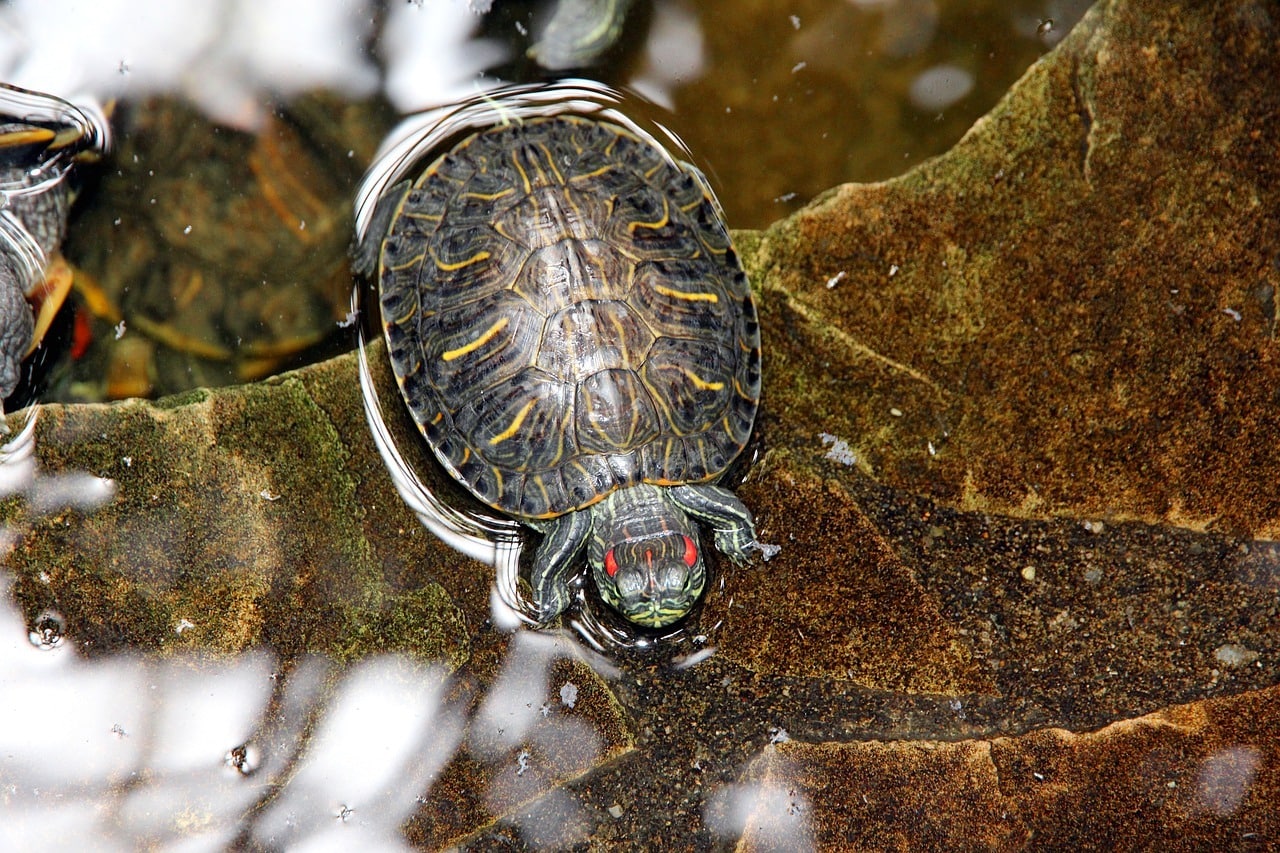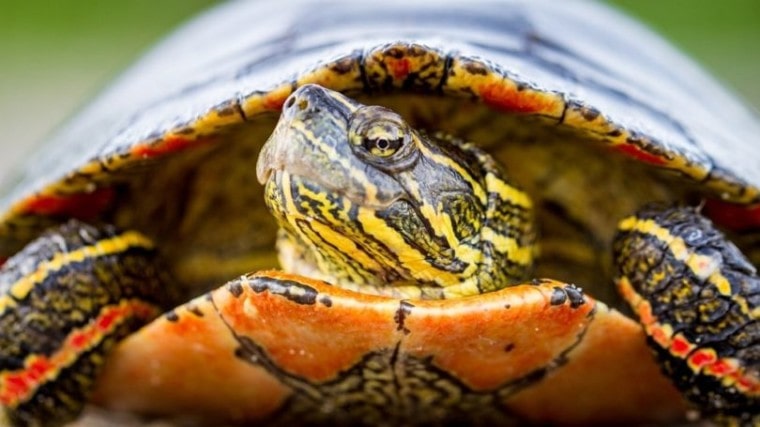
The painted turtle is one of the most commonly found wild turtles in the United States, and these tiny turtles are often kept as pets. They are becoming popular pets in the U.S. due to their brightly colored markings from which they get their name and their relatively low-maintenance needs. That said, these animals are still a massive responsibility to care for, and not all states allow keeping them as pets.
If you are considering getting a painted turtle as a pet, read on for in-depth information on how to properly care for and look after these animals, interesting facts about them, and more!
Painted Turtle Facts
There are four different types of painted turtles; the Eastern painted turtle, the Midland painted turtle, the Western painted turtle, and the Southern painted turtle, all of which have different native ranges in the U.S., but their care requirements in captivity are similar.
Painted turtles live for 20–25 years on average but can live for up to 50 years in captivity, and this is in large part why they are such a massive responsibility. You can tell the age of a painted turtle by the rings on their shells. When the painted turtle grows, they shed the outside layer of plates on their shell, called scutes, and these new plates leave distinct rings that can be counted to reveal the turtle’s age.
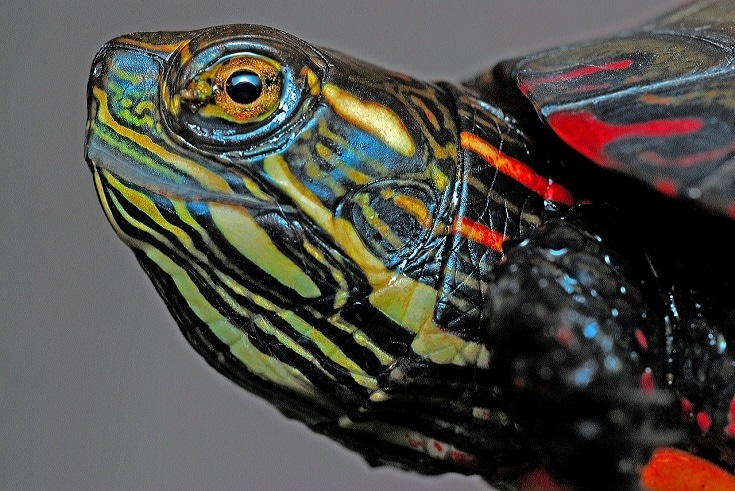
These turtles are fairly small in size, reaching about 5–6 inches in length on average, but have been found up to 12 inches long. Shell size is another way of estimating the age of a painted turtle: By about 2 years old, the shell should be around 4 inches long and will reach 6-8 inches at 4 years old. Males are usually smaller than females, although not by much.
Are Painted Turtles Good Pets?
Due to their docile nature, painted turtles make great pets, but they require dedicated care and maintenance, making them more difficult to care for than most other common pets. The long lifespan of these animals also makes them a massive responsibility that will be with you for decades.
If you are looking for a pet that you can handle regularly, the painted turtle is probably not the best choice. These animals are fairly shy and generally do not enjoy being handled and are especially not good pets for younger children. They are docile, slow-moving animals, and picking them up can cause them significant stress, so it should be kept to an absolute minimum. Picking them up can make them feel threatened, in which case, they are known to bite, scratch, and even urinate on people if they feel frightened.
Painted turtles are diurnal, meaning they are active during the day, usually basking in the sun and hunting for food. In the wild, they will hibernate during winter, but with the right temperature regulation in their enclosure, captive turtles typically do not hibernate because there is no need to without the temperature change.
They make good pets strictly from an observational point of view, as they are wonderful creatures to watch and enjoy from a distance.
Where Can I Get a Painted Turtle?
Painted turtles are readily bred in captivity, and as such, there are a large number of breeders, and these animals are fairly easy and inexpensive to get. Painted turtles typically breed in the summer months, so captive-bred babies are only available from May to September.
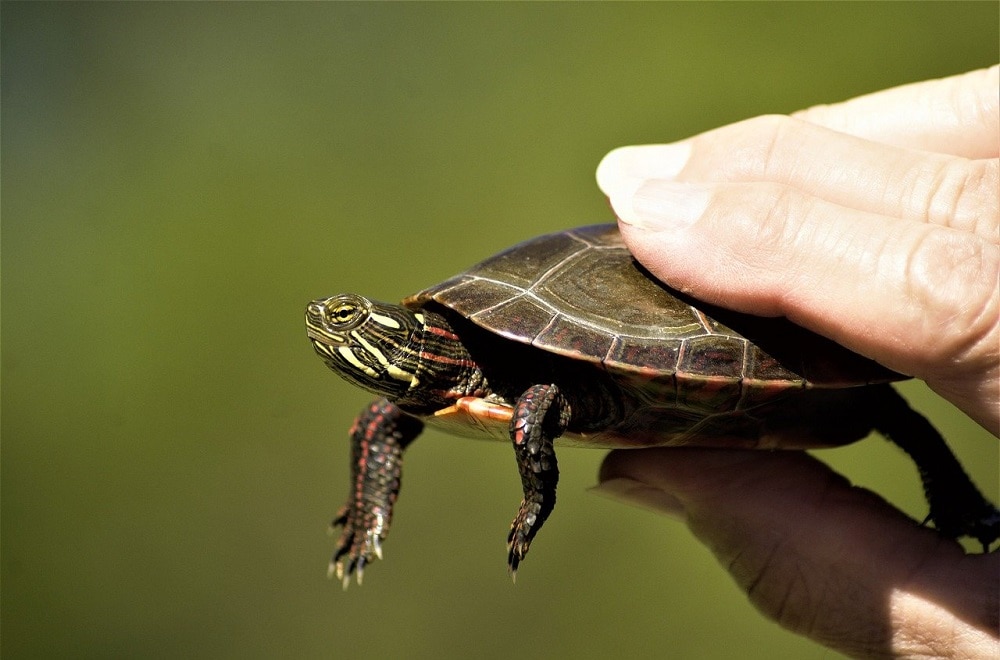
Painted turtles typically range from $50–$150 for a captive-bred baby but can be found for as little as $30. The prices can vary depending on several factors, namely age and breed. Western and Southern painted turtles are usually priced a little higher, depending on where you buy them from.
How Much Does It Cost to Own a Painted Turtle?
A painted turtle is not a hugely expensive animal to look after, with low initial setup costs, purchase costs, and fairly low feeding costs. That said, their long lifespan can make the costs add up over time, and they are definitely a long-term commitment.
For housing and supplies, you can expect to pay anywhere from as little as $200 to as much as $1,000, depending on how complex you want your enclosure to be. Of course, this is a one-time investment and will last the lifetime of your turtle. This includes around $100–$300 for the cage, $100–$400 for cage supplies and equipment, and $50–$100 for food bowls, bedding, and other extras.
Your turtle will need an annual checkup with the vet to make sure all is well health-wise, usually costing $50–$100, depending on what needs to be done. Bedding will need to be changed regularly, which will cost roughly $20 per month, and food and treats are likely to cost you $20–$50 per month.
- You may also like: How to Take Care of a Pet Tortoise (Care Sheet & Guide)
What Kind of Home Does My Painted Turtle Need?
Water
Painted turtles in the wild live close to bodies of water like streams and ponds, and your turtle enclosure should mimic this with a water source that is at least 10–12 inches deep and a minimum of 10- to 15-gallon tank. As your turtle reaches adulthood, you’ll want to increase this to a minimum of 20 gallons and add in an extra 10 gallons for every other turtle living in the enclosure. They’ll also need a basking area, preferably underneath a light that will help them thermoregulate. These turtles love being in the water, so your pond should be equipped with a natural substrate like sand or stones, live plants, and a small hiding place where they can feel safe.

Lighting and temperature regulation
In their natural environment, painted turtles take in a large amount of sunlight throughout the day, which is vital for getting vitamin D. If your turtle will be living indoors, you’ll need to supplement this with lighting, both incandescent (which is used to heat the tank and should be set up over basking areas) and fluorescent, for overall enclosure lighting. An ultraviolet light is also highly recommended for painted turtles to help your turtle with the synthesis of vitamin D.
Painted turtles are ectothermic, meaning they need external sources of heat to warm their bodies. You’ll need to provide this heat in their enclosure with a submersible underwater heater or under-tank heater and keep the temperature closely monitored. The water should be kept at 75–80 degrees Fahrenheit and the ambient air temperature should stay around 80–85 degrees Fahrenheit.
Shelter
Besides basking spots, painted turtles will need a private space to hide away and feel safe. This can be created with fake or real plants underwater, but make sure that your turtle cannot get stuck and drown. Check that they can easily climb out of the water to their warm basking spot.
Accessories
Painted turtles don’t need much to be happy and healthy. That said, you’ll want their enclosure to mimic their wild habitat and look as natural as possible. Turtle-safe plants are a great addition, along with flat rocks, driftwood, and pebbles. Make sure the substrate is large enough that your turtle cannot swallow it, as this can cause digestive issues. Very fine gravel-type substrates should be avoided.
What Should I Feed My Painted Turtle?
Painted turtles are omnivores and can eat a large variety of foods. They will eat both plants and insects and worms with enthusiasm.

Live, fresh foods like lettuce, leafy vegetables, worms, crickets, and guppies are great, but there are high-quality commercial turtle foods available too. These foods are designed for every life stage of your turtle and are optimized to give them all the vital nutrients that they need. Check the ingredient list carefully, as turtles need 30–40% protein and very low fat content.
Adult painted turtles only need to be fed once every 2–3 days, or they can become overweight. Occasional supplementation is also a good idea with painted turtles. Calcium blocks can be added to their tanks for mineral supplementation, but vitamin A is arguably the most important supplement that they may need. They should get this vitamin from a healthy and balanced diet but may need supplementation from time to time.
How Do I Take Care of My Painted Turtle?
Feeding
In the wild, young painted turtles eat primarily meat, and they begin to add in plants as a food source as they age. You should replicate this with turtles in captivity and feed them on a variety of insects and worms while they are still growing, and gradually add in more healthy plant foods later. Turtles are messy eaters, and we highly recommend feeding them in a container separate from their living and swimming space. This will save you a ton of time because you won’t need to clean out their enclosure after every feeding.
Handling
Painted turtles do not enjoy handling and may even bite or scratch. You should aim to handle them as little as possible to avoid causing them stress and anxiety. These are not affectionate or cuddly animals at all, and they enjoy being alone most of the time. When handling your painted turtle, there are a few tips to try to reduce any stress that they may go through:

Shedding
Painted turtles, like many other aquatic turtles, shed their shells, or scutes, annually. This is perfectly normal behavior and nothing to panic about; your turtle is simply making room for their shell to grow bigger. Turtles also shed their skin, like other reptiles, and this helps turtles rid their skin of infections or parasites.
Brumation
In the wild, painted turtles will typically hibernate in winter and can survive underneath icy water for well over 100 days. Technically, this practice is not true hibernation, but rather brumation, and it is a period of deep sleep and dormancy. The key difference between this and hibernation is that on warm days, painted turtles may come up out of the water and bask in the sun. In captivity, however, painted turtles do not hibernate because the temperature in their enclosures typically remains stable.
Habitat maintenance
Your painted turtle’s tank will need to be cleaned regularly, usually around once or twice a month. Even between deep cleans, however, you should make a habit of spot cleaning your turtle’s enclosure every 1–2 days, picking up old food or droppings. Remember that painted turtles don’t like to be handled, and this will help minimize the need for deep cleaning and thus, handling.
Remove everything from the tank, and clean the tank with a warm—and very diluted!—bleach-and-water mix to kill off any bacteria. Let the tank sit for 10-20 minutes, and then thoroughly rinse it again with warm water and let dry for a couple of hours. All the rocks and fake plants can be cleaned with soapy water and rinsed thoroughly before being put back in to remove algae. Remember to always wear gloves when cleaning your turtle’s tank and when handling your turtle, as they can carry potentially harmful bacteria, like salmonella.
How Do I Know if My Painted Turtle Is Sick?
If you keep a careful eye on your turtle and get to know their eating and activity habits, spotting illness can be quick and easy, and you will be able to treat them much faster and thus, have a much higher degree of success. A clean enclosure and balanced diet will help reduce the chance of illness in your painted turtle.

That said, despite best efforts, pets can still get sick. Here are common illnesses found in painted turtles and how to spot the signs.
Final Thoughts
Owning a painted turtle is a wonderful experience, and in general, these docile animals are easy to care for. That said, they are more difficult to keep than many other turtle species, do not enjoy being handled, and have exceedingly long lifespans, making them a massive responsibility to undertake.
If you are looking for a docile, quiet pet that doesn’t require your constant attention, the beautiful painted turtle is a wonderful choice and will keep you company for years to come!
- Next on your reading list: Do Turtles Shed?
Featured Image Credit: LisaTaylorPhoto, Pixabay




